
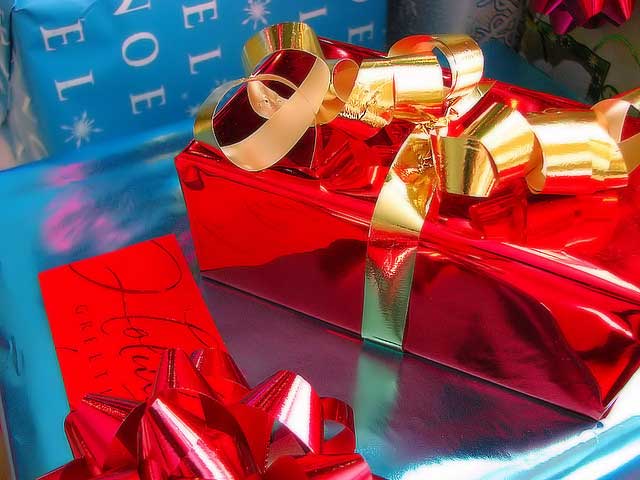
Christmas Traditions
Gift Giving
The idea of presenting people you love with gifts is as old as the human race. The idea of exchanging gifts at Christmas time originated with the birth of Jesus, when three wise men traveled to deliver gifts of gold, frankincense, and myrrh to the newborn baby. Shepherds in the fields also came to give gifts to the newborn baby Jesus.
Even though the roots of the Christmas presents extend to ancient times, the gift giving tradition we are familiar with today owes perhaps the most to Victorian England. The Victorians, who brought a renewed warmth and spirit to Christmas after it had experienced a long period of decline, made the idea of family part of the celebration. Friendliness and charity filled many hearts during their Christmas season, so giving gifts was natural. The ultimate reason for giving a gift was as an expression of kindness, a sentiment that went nicely with the historical tradition of the holiday. Also the first known commercially produced Christmas card was designed by John Callcott Horsley of London in 1843. Together with cards and decorations, the Victorian era saw the introduction of many of the Christmas traditions currently enjoyed.
Presents are opened on different days over the world as well. The earliest presents are opened is on St. Nicholas' Eve on December 5th when children in Holland often receive their presents. On St. Nicholas' Day (December 6th) children in Belgium, Germany, Czech Republic and some other European countries open some of the presents.
Children in the UK, USA and many other countries, such as Japan, open their presents on Christmas Day, December 25th. The latest presents are opened on January 6th (a month after the earliest). This is known as Epiphany and is mainly celebrated in Catholic countries such as Spain and Mexico.

Christmas Trees
Long before the advent of Christianity, plants and trees that remained green all year had a special meaning for people in the winter. Just as people today decorate their homes during the festive season with pine, spruce, and fir trees, ancient peoples hung evergreen boughs over their doors and windows. In many countries it was believed that evergreens would keep away witches, ghosts, evil spirits, and illness.
Early Romans marked the solstice with a feast called the Saturnalia in honor of Saturn, the god of agriculture. The Romans knew that the solstice meant that soon farms and orchards would be green and fruitful. To mark the occasion, they decorated their homes and temples with evergreen boughs.
In Northern Europe the mysterious Druids, the priests of the ancient Celts, also decorated their temples with evergreen boughs as a symbol of everlasting life. The fierce Vikings in Scandinavia thought that evergreens were the special plant of the sun god, Balder.
Germany is credited with starting the Christmas tree tradition as we now know it in the 16th century when devout Christians brought decorated trees into their homes. Some built Christmas pyramids of wood and decorated them with evergreens and candles when wood was scarce. It is a widely held belief that Martin Luther, the 16th-century Protestant reformer, first added lighted candles to a tree. Walking toward his home one winter evening, composing a sermon, he was awed by the brilliance of stars twinkling amidst evergreens. To recapture the scene for his family, he erected a tree in the main room and wired its branches with lighted candles.
In 1846, the popular royals, Queen Victoria and her German Prince, Albert, were sketched in the Illustrated London News standing with their children around a Christmas tree. Unlike the previous royal family, Victoria was very popular with her subjects, and what was done at court immediately became fashionable—not only in Britain, but with fashion-conscious East Coast American Society. The Christmas tree had arrived.
The early 20th century electricity brought about Christmas lights, making it possible for Christmas trees to glow for days on end. With this, Christmas trees began to appear in town squares across the country and having a Christmas tree in the home became an American tradition.
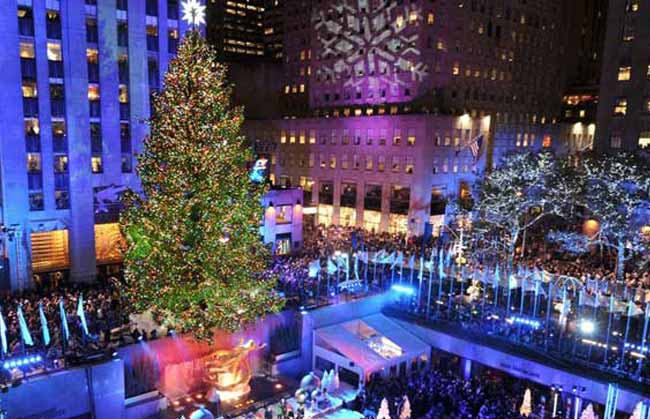
The first tree at Rockefeller Centre was placed in 1931. It was a small unadorned tree placed by construction workers at the centre of the construction site. Two years later, another tree was placed there, this time with lights. These days, the giant Rockefeller Centre tree is laden with over 25,000 Christmas lights.
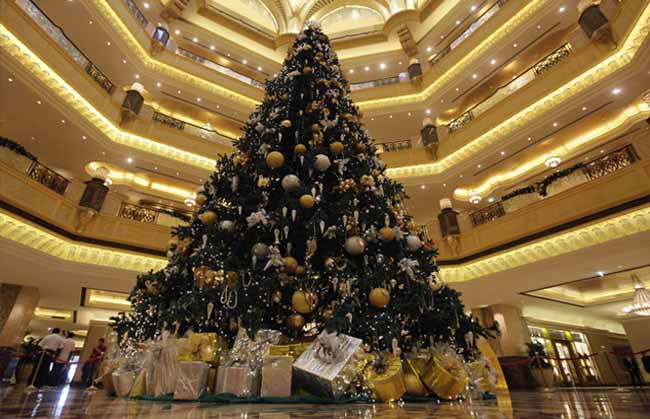
A Christmas tree that costs $11 million stands in the lobby of Abu Dhabi's Emirates Palace hotel. This 43-foot (13-meter) tree is decorated with 131 ornaments that include gold and precious stones such as diamonds and sapphires. Christmas spirit is not rare in the United Arab Emirates, which is officially Muslim but hosts a huge foreign population.
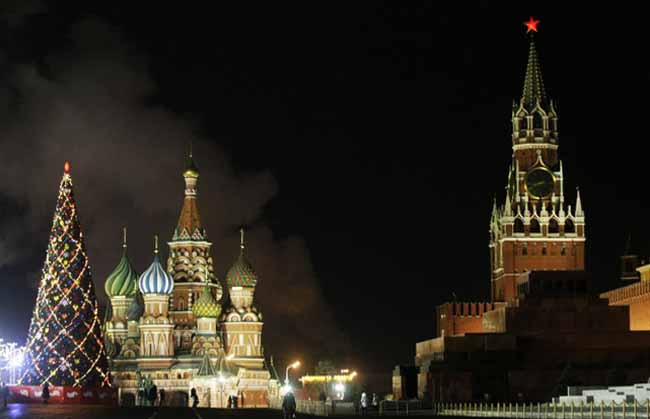
It has begun to be a tradition--foregone during the Soviet era--that public places in Russia are decorated for the New Year and Christmas. This tree decorates Moscow's Red Square in front of St. Basil's Cathedral in celebration of the coming New Year and Orthodox Christmas (celebrated on January 7).

Outside the Bird's Nest, also known as the National Stadium, Beijing. Christmas in China is treated more like Saint Patrick's Day or Valentine's Day for going out and being with friends, not for staying in with family. Along with this commercialized and religiously sterilized version of Christmas, Chinese Christians still face restrictions against a Western-style holiday.
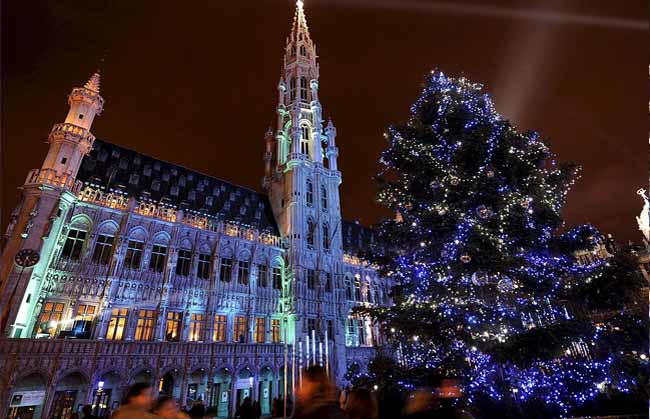
The Grand Place in the centre of Brussels hosts a real Christmas tree each year, taken from the Ardennes forest. The normal height for these trees is around 20 metres (66 ft) high. The Grand Place itself dates from the 17th century and has played host to a Christmas market each year since 2000.

Christmas Ornaments
The tradition of Christmas Ornaments is a much disputed one. The most popular theory holds that the tradition was started by a monk who came to Germany in the 7th-8th century to preach. It is said that this monk was Saint Boniface, the Apostle of the Germans. According to history, the saint was the first one to bring a fir tree to the German people to decorate, for he claimed that its triangular shape represented the Holy Trinity - God, his son Jesus, and the Holy Spirit. The tradition was lapped up by the devout Germans who started decorating the Christmas tree in a liturgical way with simple, white candles. This however, changed in the 15th century when ornaments began to be incorporated into the Christmas decorations in Germany. In Latvia, circa 1510, a fir tree was decorated with roses which was associated with the Virgin Mary. This event is often hailed as the pioneer of modern Christmas decorations.
Until the 1880s, Christmas tree decorations had mainly been the creative domain of family and friends and the only ornaments available in the market were German hand-cast lead and hand-blown glass decorations. But the 1880s saw many German entrepreneurs seriously thinking of manufacturing ornaments on a mass scale and selling these strictly as Christmas ornaments. The idea was soon translated into reality. The glass firms around Lauscha, the hub of the glass ornament trade in Germany, which had until then been engaged in making glass articles such as bottles and marbles soon began to create little glass toys like molds of children, saints, famous people, animals and other forms and released them in the market.
This new type of Christmas ornament was an instant success and was met with a huge demand. Soon, nearly every family in and around Lauscha became involved in some way or other in the creation of Christmas glass ornaments working either in a factory or in a home-based foundry. Now each ornament had a touch of individual craftsmanship and became highly prized possessions.
Christmas ornaments are now an indispensable part of Christmas decorations. The manufacture and sale of Christmas ornaments makes one of the greatest markets worldwide. Despite being increasingly commercialized, the use of Christmas ornaments lend its own special charm, an alacrity to the old tradition of Christmas every year and infuse true enthusiasm in the Christmas celebrations.

Poinsettias
Poinsettias are believed to have originated in central and south America and were recorded, described, and revered by the ancient Aztec peoples.
This flowering plant eventually became a symbol of Christmas to the Mexican culture and it became a tradition to use poinsettias to decorate during Christmas time.
In 1824 the American Ambassador to Mexico, Joel Poinsett attended church service on Christmas Eve and was impressed with the bright red flowers used to decorate the church altar. Poinsett took seeds with him when he went back to America and shared the plants with local churches during Christmas celebrations over the next several years.
Because Joel Poinsett was so closely associated with the plant in the United States, people who bought them started calling them Poinsett's plants or Poinsettias. The shape of the poinsettia flower and leaves are sometimes thought as a symbol of the Star of Bethlehem which led the Wise Men to Jesus. The red colored leaves symbolize the blood of Christ. The white leaves represent his purity.
Today, millions of Poinsettia plants decorate homes throughout the world. In Latin America the bright red flowers are known as the 'Flores de Noche Buena' ('Flowers of the Holy Night').

Sources: History.com, merry-christmas.com, Christmas Center, Wikipedia, whychristmas.com, washingtonpost.com
By Claudia Schalkx
Claudia is a multilingual consultant fluent in Spanish, English, Italian, and Dutch with over 25 years international experience in communications, public relations & marketing. She was born in Venezuela from Dutch parents, has lived and worked in Venezuela, Colombia, Curacao, St. Maarten, USA, Italy and The Netherlands where she resides. She is Colors Chief Editor. Her duties include content selection, revision & editing, finding and attracting collaborators, and identifying new business opportunities for Liberty Publications. More info
Pictures: Flickr / voxtheory, Shakh Aivazov, AP / Kathy Willens / Alexander F. Yuan, Jason Lee / Reuters, Victoria P. / Fotolia, wallseemly.com
More Global & Local /
Do you wish to write for Colors?











